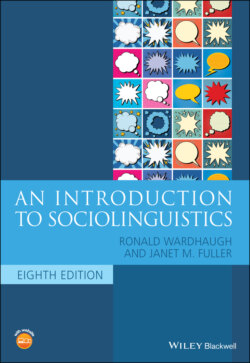Читать книгу An Introduction to Sociolinguistics - Ronald Wardhaugh, Janet M. Fuller - Страница 67
Linguistic boundaries
ОглавлениеIn sociolinguistics, we need a specific definition of a group in order to do research. The kind of group that sociolinguists have generally attempted to study is called the speech community (see Patrick 2002 and Morgan 2001, 2004, for a general survey of the research). For purely theoretical purposes, some linguists have hypothesized the existence of an ‘ideal’ speech community. However, such a speech community cannot be the concern of sociolinguistics: it is a theoretical construct employed for a narrow purpose. Consequently, we must try to find some alternative view of speech community, one helpful to investigations of language in society rather than necessitated by abstract linguistic theorizing.
Lyons (1970, 326) offers a definition of what he calls a ‘real’ speech community: ‘all the people who use a given language (or dialect).’ However, that merely shifts the issue to making the definition of a language (or of a dialect) also the definition of a speech community. If, as we saw in chapter 2, it proves virtually impossible to define language and dialect clearly and unambiguously, then we have achieved nothing. It is really quite easy to demonstrate that a speech community is not coterminous with a language: while the English language is spoken in many places throughout the world, we must certainly recognize that it is also spoken in a wide variety of ways, in speech communities that are almost entirely isolated from one another, for example, in South Africa, in New Zealand, and among anglophone immigrants in China. We must ask ourselves in what sense does this modern lingua franca produce a speech community that might be of interest to us, that is, ask what else is shared other than the very language itself. Furthermore, if speech communities are defined solely by their linguistic characteristics, we must acknowledge the inherent circularity of any such definition in that language itself is a communal phenomenon. Language users do use linguistic characteristics to achieve group identity with, and group differentiation from, other language users, but they use other characteristics as well: social, cultural, political, and ethnic, to name a few. Our search must be for criteria other than, or at least in addition to, linguistic criteria if we are to gain a useful understanding of ‘speech community.’
We should also note that a recognizable single speech community can employ more than one language, whether we use national boundaries to define it (e.g., Switzerland, Canada, Papua New Guinea, all countries with more than one official language), city (or city‐state) designations (e.g., Berlin, Singapore, New York City, where multiple languages are used for everyday interactions, education, and commerce), or neighborhood boundaries (e.g., in Little Village in Chicago you can hear both Spanish and English and in San Francisco’s Chinatown both Cantonese and English are commonly used). While these speech communities are all defined in terms of geographic areas, as we will see in the discussion below, there are other criteria besides language and region we can use to define speech communities.
